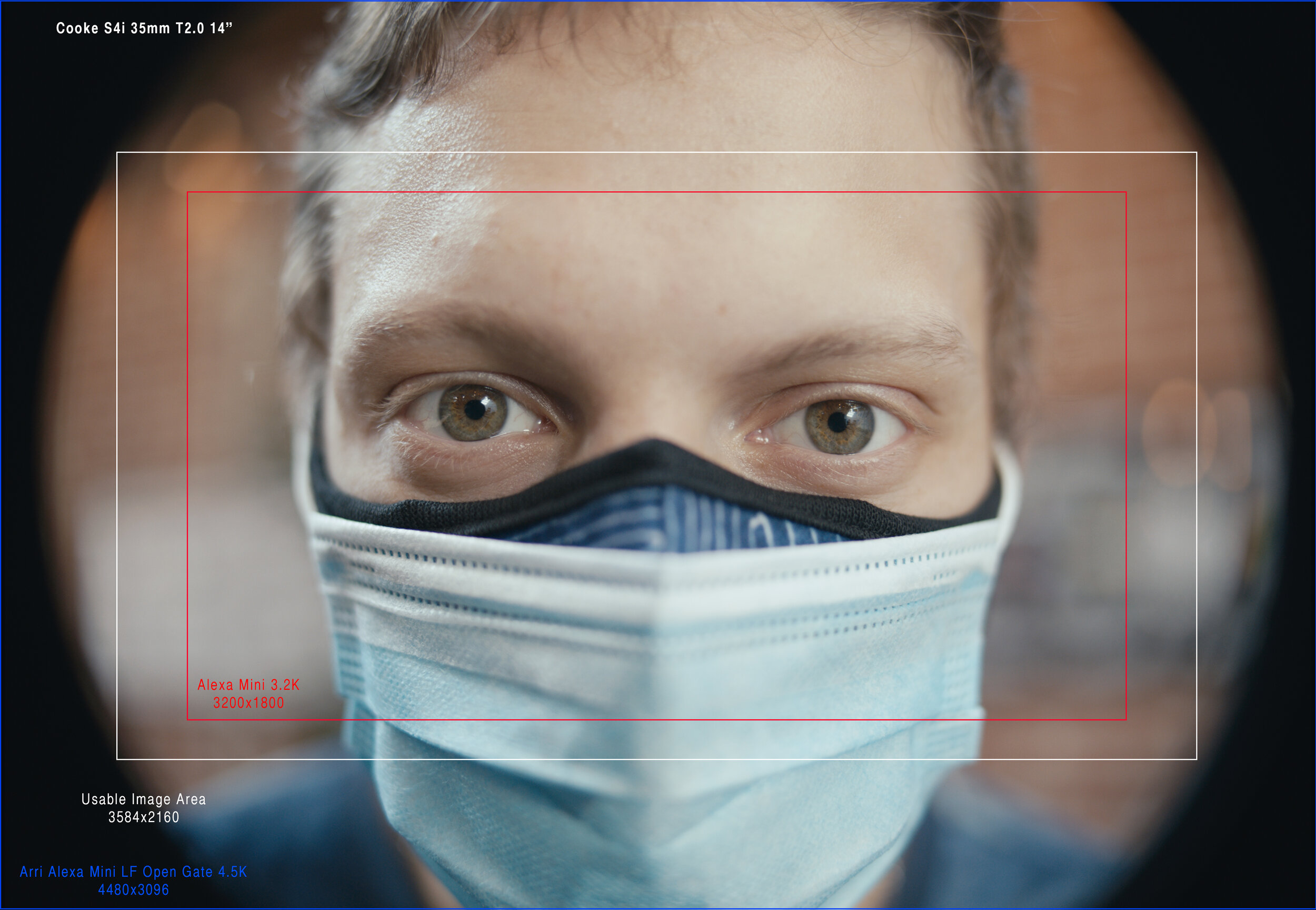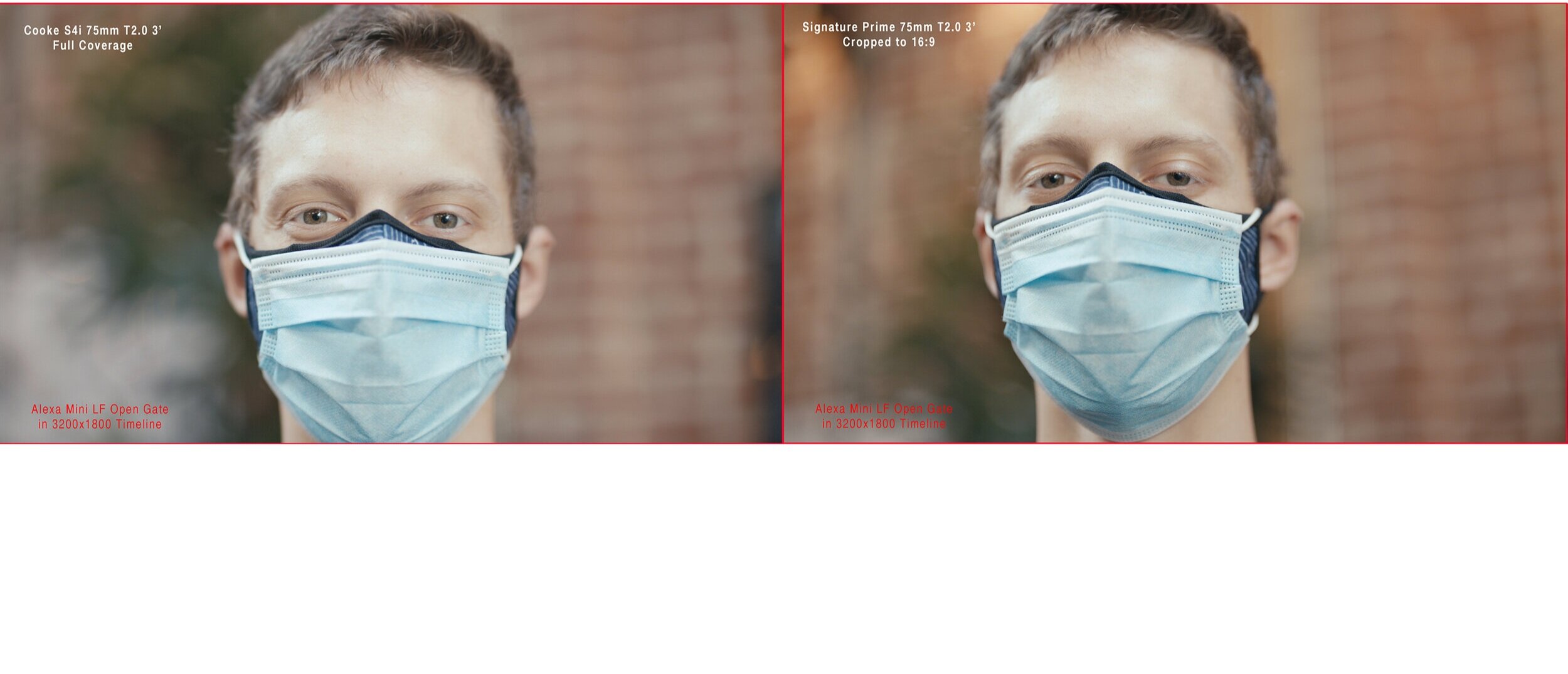Super 35 vs Full Frame Lens Test
General Notes
The purpose of this test was to determine the the feasibility of utilizing Super 35 glass on the Alexa Mini LF. I wanted to know if it was worth shooting LF if you are not using LF glass. It Should be noted that this test is in no way precise. We shot with both an Alexa Mini LF in 4.5k Open Gate and a Super 35 Mini in 3.2k, while the cameras were as close as we could get them, they are not in exactly the same spot. Especially on wider lenses close up, this slight misalignment can make very deceiving changes to how you perceive the image. We intentionally shot close to the subject, as the ability to get the camera closer to the actor while having a wider field of view is one of the largest artistic selling points of large format photography. Unfortunately, this makes it hard to discern between different focal lengths, as frame sizes across the board are relatively similar. I consider this test to be less of a comparison of formats, but rather simply a test of coverage on specific sets of primes. We used Cooke S4i Zeiss Superspeed MK II lenses. Additionally, a set of full frame Arri Signature Primes were used as a control group of sorts.
To interpret the graphics, the blue area is the full 4480x3096 resolution straight from the Mini LF sensor. For the ease of comparing formats, I used the 3200x1800 image from the Super 35 Mini as the standard finishing resolution for both cameras, this is indicated in red. The white box refers to the maximum usable area of a specific lens’ image circle. In the context of this test, the extraction refers to the amount a lens must be scaled down to fit in the 3200x1800 timeline. For instance, a lens with a usable image of 3520x1978 is 10% greater than 3200x1800. Therefore, it is scaled down 10% to fit. In this instance, a larger percentage, means more of the LF sensor is used. As a point of reference, the Arri Signature Primes require a 28% extraction to fit horizontally in the 3200x1800 timeline.
Cooke S4i 18mm on the Alexa Mini LF 4.5K open Gate:
When dropped into a 3200x1800 timeline, a 10% extraction yielded the best compromise between field of view, and passable amount of vignetting:
As a base line of comparison, here is an Arri Signature prime, also at a T2 and 14” away, shooting on the Mini LF, and Dropped into a 3.2k Timeline. Notice the much sharper focus fall off:
Compare this to the 18mm on the S35 mini, shooting 3.2k:
Side by side: Cooke S4i 18mm on the LF on the left, compared to the full frame Signature Prime on the right:
Cooke S4i 25mm on the Alexa Mini LF 4.5K open Gate:
When dropped into a 3200x1800 timeline, a 10% extraction also yielded the best compromise between field of view, and passable amount of vignetting:
25mm Arri Signature Prime at 14”:
Super 35 Mini, in 3.2k:
Side by side: Zeiss Superspeed 35mm on the LF on the left, compared to the full frame Signature Prime on the right:
Zeiss Superspeed 25mm on the Alexa Mini LF 4.5K open Gate:
By comparison, the image circle on the 25mm Superspeed is larger, resulting in much better coverage from the start: (Note the camera is 4” closer than the Cooke 25mm.)
20% extraction, placed into a 3.2K timeline:
Here is the 25mm Superspeed, also 10” away, on the Super 35 Mini: (Disregard the color and lighting shifts, the tests were not done in a controlled environment and were subject to changing clouds)
Side by side: Zeiss Superspeed 35mm on the LF on the left, compared to the full frame Signature Prime on the right: (Note the Signature Prime is 14” while the Superspeed is at 10”)
Cooke s4i 35mm on the Alexa Mini LF 4.5K open Gate:
The 35mm Cooke S4i fares only slightly better than the 25mm, needing a 12% extraction
With a 12% extraction:
The 35mm Signature Prime. I suspect this is actually further than 14” due to the frame size and focus fall off. I believe it is actually 22”:
Side by side: Cooke S4i 35mm on the LF on the left, compared to the full frame Signature Prime on the right:
Zeiss Superspeed 35mm on the Alexa Mini LF 4.5K open Gate:
The 35mm performs a bit better than the 25mm, needing a 23% extraction:
Coverage on the 35mm is pretty good, needing a 23% extraction:
35mm Superspeed on the Super 35 Alexa Mini:
Side by side: Zeiss Superspeed 35mm on the LF on the left, compared to the full frame Signature Prime on the right: (Once again, I believe the Signature Prime is actually further than 14” due to the focus fall of, and was miss slated)
Cooke s4i 50mm on the Alexa Mini LF 4.5K open Gate:
The 50mm shows improvement, but still requires an extraction of 20%:
Image rescaled with 20% extraction:
Compare to a 47mm Arri Signature Prime:
And the 50mm S4i on the Super 35 Alexa Mini
Side by side: Cooke S4i 50mm on the LF on the left, compared to the full frame Signature Prime 47mm on the right:
Zeiss Superspeed 50mm on the Alexa Mini LF 4.5K open Gate:
The 50mm almost entirely covers, needing only a slight extraction. As expected, longer lenses will yield better coverage.
Dropped into the 3200x1800 timeline scaling down 25% yields passable coverage: (Remember, 28% will result in full coverage when scaled down from the 4.5K timeline into the 3.2K timeline.)
50mm Superspeed on the Super 35 Mini:
Side by side: Zeiss Superspeed 50mm on the LF on the left, compared to the full frame Signature Prime 47mm on the right:
Cooke S4i 75mm on the Alexa Mini LF 4.5K open Gate:
The 75mm covers the LF in Open Gate with no extraction needed:
Here it is reframed into 3.2K 16:9:
The 75mm Signature Prime as a comparison:
75mm Cooke S4i on the Super 35 Mini:
Side by side: Cooke S4i 75mm on the LF on the left, compared to the full frame Signature Prime 75mm on the right:
Zeiss Superspeed 85mm on the Alexa Mini LF 4.5K open Gate:
The 85mm covers the LF in Open Gate with no extraction needed:
Here it is reframed into 3.2K 16:9:
Here is the 85mm on the Super 35 Mini in 3.2K:
Side by side: Zeiss Superspeed 85mm on the LF on the left, compared to the full frame Signature Prime 75mm on the right:








































